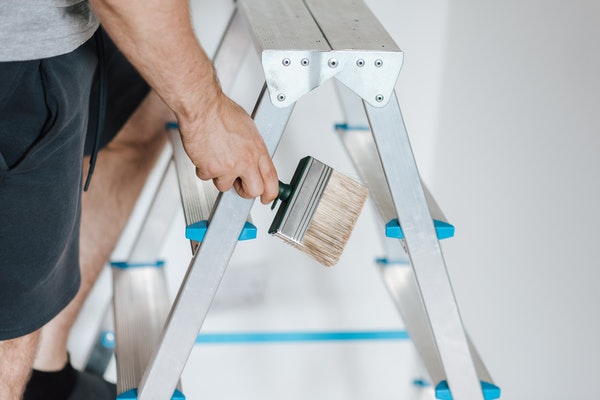
A ladder stand-off is an ingenious piece of technology that allows wide range and flexibility as you use a ladder, without sacrificing your personal safety. It's essentially a metal bracket that fixes to the rungs of your ladder; metal hooks fix it securely into place, and feet protrude outwards to balance the ladder against the wall.
The legs press against the wall surface in lieu of the ladder, holding it away from the wall giving you a greater range of motion and accessibility. This also prevents you from having to lean back dangerously to reach angles you couldn't reach before; an action that could potentially cause a serious accident.
How to Safely Use a Ladder Stand-off:
Step One:
Determine where you want the stand-off to sit on your ladder. It will have different effects at different heights, so measure your ladder against the surface you’re working on, and plan accordingly.
Step Two:
Once you’re ready to affix the stand-off to your ladder, line up your stand-off with the appropriate rung and clip it in place.
Step Three:
Different stand-offs have different safety features, to ensure that the stand-off doesn’t detach from the ladder as you’re working. Ensure that all safety features have been engaged, and then double-check all fastenings as a precaution. (These safety features could be in the form of a cable, rope, or elasticated hooks.)
Step Four:
Once you’re sure your stand-off is safely secured, lift up your ladder and place it against the surface you’ll be working against. Ensure all feet of the ladder are securely on the ground on an even surface, and the feet of the stand-off are pressed firmly against the wall. Give the ladder a little shake to ensure that everything is secure and won’t dislodge or slip when the pressure of your weight is applied.
Step Five:
Once you’re confident that everything is safe and the ladder is in the correct place, slowly climb the ladder, distributing your weight as evenly as you can on each side. Once you reach the top of the ladder, you will now be in an optimal position to have the greatest range and work safely.
When to Use a Ladder Stand-off?
A ladder stand-off is a useful tool to have when working on elevated surfaces that are uneven and/or have multiple depths. A good example of when a stand-off would be useful is cleaning guttering on a roof, which juts out significantly from the wall surface you're resting your ladder against.
The stand-off holds the ladder away from the wall of the house to give you greater access. The design of the stand-off relieves pressure and distributes it evenly, further reducing the potential of damage to guttering, ceiling tiles, etc that might occur from the ladder knocking and pressing against them.
How to Stay Safe When Using a Ladder:
When preparing to use a ladder, it's important to perform the appropriate safety checks every time.
1) Ladder Quality.
Has the ladder been damaged? Is everything working as it should be? Is it rusty or in need of oiling? Ensure all safety mechanisms are locked correctly.
2) Check Surfaces.
Check the surface where you'll be propping the ladder. Is it slippery or uneven? Is the ladder at risk of slipping or tipping? Is there enough space to angle the ladder in such a way that you're not at risk of overbalancing the ladder as you climb and work from the top?
3) Recognise Potential Hazards.
Check for potential hazards around your work area; is there anything nearby that could knock the ladder and cause it to fall as you're working? Some examples may include children playing ball games, dogs, or vehicles.
4) Don't Misuse the Ladder.
Don't exceed the limits and natural capacity of the ladder. Different ladders have different specs including load-bearing capacity. Don't use your ladder for anything other than its intended purpose.
5) Don't Push Your Own Limits.
Don't push your own limits. Overreaching is dangerous and causes many ladder-related accidents. Tools like stand-offs exist to help you improve your reach capacity safely, and if you still can't reach, dismount your ladder and reposition it appropriately.
For more information on ladder safety and how you can keep yourself out of danger, check out the link below for a handy guide from the Ladders Association on how to use ladders safely.
Ladder Safety Guide
There are a wide range of uses for a ladder stand-off. Remember to practice safely, and if you think a stand-off is something you might need for a future or current project, click the link down below to shop for our tried and tested high-quality ladder stand-offs. If you have any questions about what ladder might be right for you, contact us here and we'll do everything we can do to help you out.
Shop Ladder Stand-Offs














